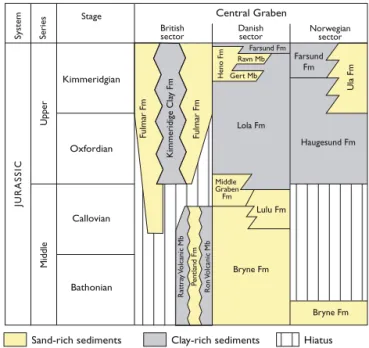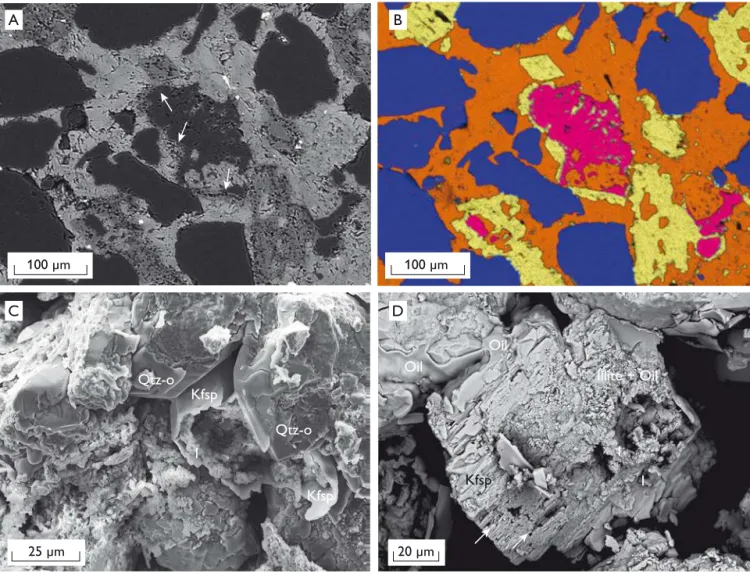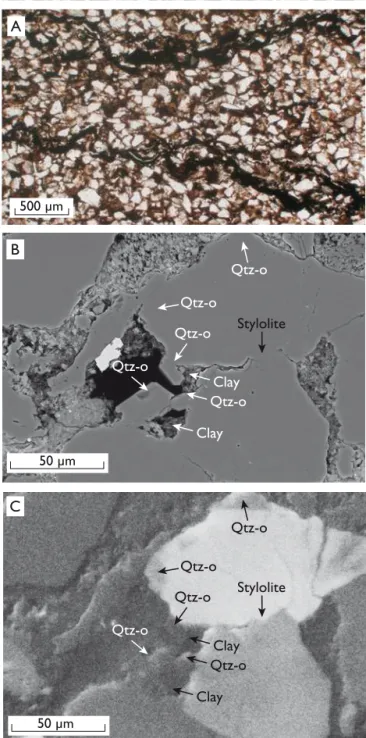Upper Jurassic quartz-rich sandstones in the North Sea Basin are important reservoir rocks for oil and gas, and one of the latest discoveries of oil in the Danish sector was made in the area of the Hejre wells that penetrated such sediments (Fig. 1). The reservoir properties of sandstones are strongly influ-enced by diagenetic alteration, i.e. the mineralogical changes that take place during burial of the sediments. The diagenetic features depend on the source area, depositional setting, facies architecture and burial history of the sediment. The major dia-genetic features influencing porosity in Upper Jurassic reser-voir sandstones are feldspar dissolution and precipitation, preci-pitation of illite, calcite and quartz, and quartz stylolite formation. With regard to the Upper Jurassic sandstones in the Danish sector of the North Sea, the important question is: how can porosity be preserved in sediments buried at depths of more than 5 km?
The Hejre-2 well penetrated the Upper Jurassic sediments (Fig. 2) before reaching pre-Upper Jurassic volcaniclastic con-glomerates. The diagenetic features were studied in thin sec-tions of core samples with traditional petrographic techniques using transmitted light microscopy supplemented by scanning electron microscopy (SEM) of rock chips and thin sections.
Feldspar dissolution and precipitation
Previous studies of feldspar diagenesis have generally focused on the albitisation of K-feldspar, the dissolution and replace-ment of plagioclase with clay at deep burial depths, and their importance for the generation of secondary porosity (e.g. Surdam et al. 1984; Bjørlykke et al. 1992). Recent investiga-tions show that the formation of feldspar overgrowths may also be a significant early diagenetic phenomenon (Lee & Parsons 2003). Early diagenetic authigenic K-feldspar has also played an important role in the Upper Jurassic sandstones investigated here, although the volume of precipitated material is not nearly as high as the succeeding calcite and quartz cementation.
Detrital feldspar, and notably K-feldspar, is a common constituent of Upper Jurassic sediments. Authigenic K-feldspar may have formed during early diagenesis, but is now mainly preserved in calcite-cemented parts of the sandstones, where it forms overgrowths on detrital K-feldspar, perthite and albite grains (Fig. 3A, B). Authigenic K-feldspar is
com-© GEUS, 2008. Geological Survey of Denmark and Greenland Bulletin 15, 9–12. Available at: www.geus.dk/publications/bull
Diagenesis influencing the porosity of Upper Jurassic
reservoir sandstones, Danish North Sea
Rikke Weibel and Nynke Keulen
9
0°
0° 8°
58°N 58°N
50°N
8°E
Germany
United
Kingdom
North Sea
Denmark
Hejre wells
Danish
Central
Graben
500 km
Fig. 1. Sketch map of the North Sea region showing the location of the Hejre wells. The dashed lines show the borders between the national sectors.
System Series
JURASSIC
Upper
Mid
dle
Stage
Kimmeridgian
Oxfordian
Callovian
Bathonian
Central Graben
British
sector Dasectornish Norwesectorgian
F
u
lmar Fm
F
u
lmar Fm
Farsund Fm Farsund
Fm
Ula Fm
Haugesund Fm Lola Fm
Bryne Fm Bryne Fm
Middle Graben Fm
Gert Mb Ravn Mb
He
n
o Fm
Kimmeridi
g
e Cla
y Fm
Lulu Fm
Rattra
y V
olca
n
ic Mb
Pe
n
tla
n
d Fm
Ro
n
V
o
lca
n
ic Mb
Sand-rich sediments Clay-rich sediments Hiatus
mon in the vicinity of K-bearing clay-rich intervals and in the sandstone immediately overlying volcaniclastic conglomerates. Element mapping of the calcite-cemented parts of the sandstones shows the volumetric importance of the early authigenic K-feldspar phase (Fig. 3B). The marine Upper Jurassic sediments (Johannessen 2003) are expected to have had relatively high concentrations of potassium in the origi-nal pore fluids, in the K-feldspar stability field (e.g. Worden & Morad 2000). However, the large proportions of authi-genic K-feldspar associated with clay-rich intervals and the underlying volcaniclastic conglomerates could indicate an additional external supply of potassium. The volcaniclastic conglomerates have a very high K-content and must originate from a potassic alkaline volcanic source. Lee & Parsons (2003) found exceptionally high proportions of sanidine crypto
-perthites in the Upper Jurassic Humber Group, inferred to have an ultra-potassic volcanic source. Potassic volcanic sources of Early and Middle Jurassic (Furnes et al. 1982) or Permian age (Aghabawa 1993) are present in the North Sea area, but a determination of the age and location of the actual volcanic source of potassium for the Upper Jurassic reservoir sandstones require further investigations.
Remnants of albite grains are only preserved in the calcite-cemented parts of the sandstones, whereas more calcium-rich plagioclase detrital grains are almost completely lacking in the sandstones. These parts of the sandstone are instead char-acterised by K-feldspar overgrowths around voids of approx-imately the size of average detrital grains (Fig. 3C). These voids are often partly filled with illite and occasionally authi-genic quartz. The K-feldspar overgrowths presumably
precipi-10
25 µm 100 µm
A B
C D
100 µm
20 µm
Qtz-o Oil
Oil
Illite + Oil
Qtz-o Kfsp
Kfsp
I
I I
Kfsp
tated around detrital albite or Ca-rich plagioclase grains that were subsequently dissolved or replaced by clay minerals, mainly illite. It appears that dissolution of detrital albite and Ca-rich plagioclase grains led to substantial secondary porosity in the non-calcite cemented parts of the sandstones; even K-feldspar shows partial dissolution and illitisation (Fig. 3D). However, subsequent compaction and growth of authigenic phases have reduced this secondary porosity (Fig. 3B). Further -more, it is possible that the relatively high porosity in the lower parts of the sandstones originates from early precipitation of authigenic K-feldspar cement, which, similar to the detrital feldspars, was subsequently dissolved or replaced by illite re -sulting in major secondary porosity.
Quartz diagenesis: stylolites, pressure
solution and overgrowth
Quartz cementation by development of stylolites, pressure solution between adjacent quartz grains and precipitation of macro-overgrowths are important in deeper (3–5 km) buried siliciclastic reservoirs (e.g. Bjørlykke et al. 1992; Worden & Morad 2000). The investigated Upper Jurassic sediments are no exception, as detrital quartz grains are the major con-stituent of the Upper Jurassic sediments and quartz diagenesis is the major porosity-reducing feature outside the calcite-cemented areas. However, parts of the sandstones show a high porosity and are without major quartz or calcite cement. The porosity is reduced by the formation of stylolites (Fig. 4A), pressure solution and by precipitation of quartz overgrowths (Fig. 4B, C); all late diagenetic processes that took place after authigenic K-feldspar precipitation, calcite cementation and feldspar dissolution and illitisation. The stylolites appear to have evolved from primary mica-rich and detrital clay-rich (mainly illitic) laminae (Fig. 4A).
Quartz pressure solution and stylolite formation may be related to the local microphysiochemical environment where alkaline conditions formed around clays, which could lead to enhanced pressure solution of quartz through increased solu-bility or an increased dissolution rate (Tada & Siever 1989). Pressure solution has also been related to the surface charge of the illitic clays or mica (Walderhaug et al. 2006). Illitic clays are quite common in the investigated Upper Jurassic sandstones and may have led to enhanced development of stylolites. On the other hand, in sediments with high con-centrations of clay and rock fragments, stylolites may be completely absent, due to the cushioning effect of the clay matrix and ductile lithic fragments (cf. Tada & Siever 1989). The pressure solution of detrital quartz grains and stylolite formation may have released silica for the quartz overgrowths. Syntaxial quartz overgrowths are found in all parts of the Upper Jurassic sediments except for the calcite-cemented areas.
Peculiar, irregularly shaped quartz overgrowths are found in those parts of the sediments that show the highest present-day porosities (Fig. 4B, C). These peculiar quartz overgrowths
11
500 µm
50 µm
50 µm
Stylolite
Qtz-o Qtz-o
Qtz-o
Qtz-o Clay
Clay Qtz-o
Stylolite Qtz-o
Qtz-o
Qtz-o
Qtz-o Clay
Clay Qtz-o A
B
C
Fig. 4. Images showing development of quartz stylolites, quartz pressure solution and quartz overgrowths that are the main diagenetic features affecting the porosity outside the calcite-cemented parts of the sandstones.
can be interpreted as an indication of three completely dif-ferent processes. They could either be caused by an incipient introduction of hydrocarbons, which partly covered the over-growth (cf. Marchand et al. 2000). In other cases, it has been suggested that authigenic chlorite rims have inhibited or retarded quartz overgrowth (Aase et al. 1996). Aase & Walderhaugh (2005) argued that the delay of such quartz precipitation was caused by thin coatings of micron-scale quartz crystals (microquartz). In sandstones of the Hejre-2 well abundant illite, formed during alteration of feldspar, may have inhibited pressure solution and stylolite formation, as a result of the cushioning effect of the clays, and further-more have delayed the growth of authigenic quartz in the Upper Jurassic sediments.
Summary and perspectives
The quartz-rich Upper Jurassic reservoir sandstones in the Hejre-2 well are characterised by relatively high amounts of detrital K-feldspar, which most likely come from a volcanic source. Authigenic K-feldspar grew on detrital K-feldspar, perthite and albite grains and possibly Ca-rich plagioclase. The potassium for the K-feldspar overgrowths probably comes from marine pore fluids, detrital clay minerals and the underlying volcaniclastic conglomerates. The Kfeldspar over -growths were initially abundant, but were later dissolved except for the calcite-cemented parts of the sandstones. The formation of secondary porosity in the sandstones in the Hejre-2 well was mainly caused by dissolution of detrital feldspars and authigenic K-feldspar.
Quartz diagenesis prevails in the Upper Jurassic sediments in the Hejre-2 well where carbonates are absent and where illitic clays are restricted. Pressure solution and stylolite for-mation provide abundant silica, which is precipitated as quartz overgrowths. The presence of small amounts of illitic clays and mica may have enhanced the development of stylo-lites. On the other hand, relatively large amounts of illitic coatings seem to have inhibited or retarded the formation of quartz overgrowths, which otherwise could have reduced the porosity. Consequently, sandstone intervals in the Hejre-2 well with high porosities are the result of dissolution and illite replacement of detrital feldspars and early authigenic Kfeld -spar cement, thus secondary porosity was created; together with illite coatings that inhibited the formation of quartz over-growths.
Future investigations may reveal whether the diagenetic evolution of Upper Jurassic sediments in other wells is similar to that encountered in the Hejre-2 well. Another aspect worth
pursuing is to investigate if bulk rock geochemistry can be cor-related with major diagenetic phenomena.
Acknowledgement
DONG Energy is thanked for permission to publish the present infor-mation on the Hejre-2 well prior to public release of the data.
References
Aase, N.E., Bjørkum, P.A. & Nadeau, P.H. 1996: The effect of grain-coating microquartz on preservation of reservoir porosity. American Association of Petroleum Geologists Bulletin 80, 1654–1673.
Aase, N.E. & Walderhaug, O. 2005: The effect of hydrocarbons on quartz cementation: diagenesis in the Upper Jurassic sandstone of the Miller Fields, North Sea, revisited. Petroleum Geoscience 11, 215–223. Aghabawa, M.A. 1993: Petrology and geochemistry of the Rotliegendes
volcanic rocks in Denmark and their tectonic implications. Dyn -maisk/Stratigrafisk analyse af Palæozoikum i Danmark. EFP-89; område 1: Olie og Naturgas, 3, DGU Kunderapport 1993/35, 351 pp. Bjørlykke, K., Nedkvitne, T., Ramm, M. & Saigal, G.C. 1992: Diagenetic
processes in the Brent Group (Middle Jurassic) reservoirs of the North Sea: an overview. In: Morton, A.C. et al. (eds): Geology of the Brent Group. Geological Society Special Publication (London) 61, 263–287. Furnes, H., Elvsborg, A. & Malm, O.A. 1982: Lower and Middle Jurassic
alkaline magmatism in the Egersund sub-basin, North Sea. Marine Geology 46, 53–69.
Johannessen, P.N. 2003: Sedimentology and sequence stratigraphy of par-alic and shallow marine Upper Jurassic sandstones in the northern Danish Central Graben. In: Ineson, J.R. & Surlyk, F. (eds): The Jurassic of Denmark and Greenland. Geological Survey of Denmark and Greenland Bulletin 1, 367–402.
Lee, M.R. & Parsons, I. 2003: Microtextures of authigenic Or-rich feldspar in the Upper Jurassic Humber Group, UK North Sea. Sedimentology 50, 597–608.
Marchand, A.M.E., Haszeldine, R.S., MacAulay, C.I., Swennen, R. & Fallick, A.E. 2000: Quartz cementation inhibited by crestal oil charge: Miller deep water sandstone, UK North Sea. Clay Minerals 35, 201–210. Michelsen, O., Nielsen, L.H., Johannessen, P.N. Andsbjerg, J. & Surlyk, F.
2003: Jurassic lithostratigraphy and stratigrafic development onshore and offshore Denmark. In: Ineson, J.R. & Surlyk, F. (eds): The Jurassic of Denmark and Greenland. Geological Survey of Denmark and Greenland Bulletin 1, 147–216.
Surdam, R.C., Boese, S.W. & Crossey, L.J. 1984: The chemistry of secondary porosity. In: McDonald, D.A. & Surdam, R.C. (eds): Clastic diagenesis. American Association of Petroleum Geologists Memoir 37, 127–149. Tada, R. & Siever, R. 1989: Pressure solution during diagenesis. Annual
Review of Earth and Planetary Science 17, 89–118.
Walderhaug, O., Bjørkum, P.A. & Aase, N.E. 2006: Kaolin-coating of stylo-lites, effect on quartz cementation and general implications for dissolu-tions at mineral interfaces. Journal of Sedimentary Research 76, 234–243. Worden, R.H. & Morad, S. 2000: Quartz cementation in oil field sand-stones: a review of the key controversies. In: Worden, R.H. & Morad, S. (eds): Quartz cementation in sandstones. Special Publication of the International Association of Sedimentologists 29, 1–20. Oxford: Blackwell Science.
Authors’ address
Geological Survey of Denmark and Greenland, Øster Voldgade 10, DK-1350 Copenhagen K, Denmark. E-mail: rwh@geus.dk


